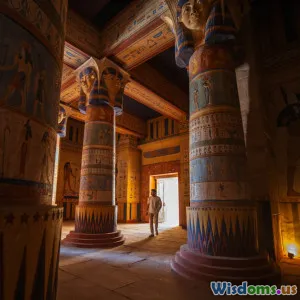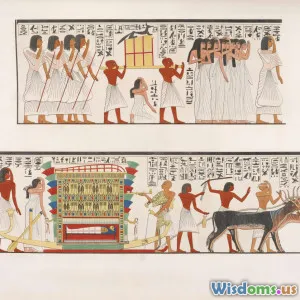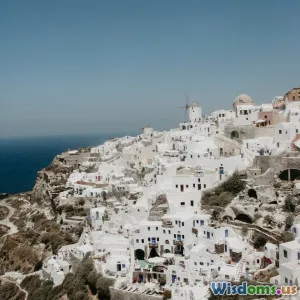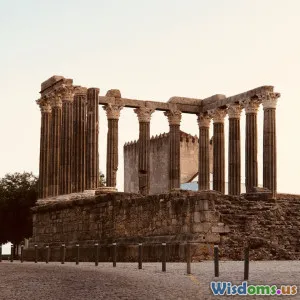
Exploring Ancient Cultures and Their Secrets
9 min read A deep dive into ancient cultures, unraveling their mysterious secrets and archaeological wonders that continue to intrigue us today. (0 Reviews)
Exploring Ancient Cultures and Their Secrets
Introduction
Few fascinations grip the human imagination quite like the mysteries of ancient civilizations. These cultures, some thousands of years old, laid down the foundations of modern society — from language and architecture to governance and philosophy. Yet, much about them remains shrouded in enigma, studied through the lens of archaeology, history, and even mythology. What secrets do these ancient peoples still hold? How did they build feats like the pyramids without modern technology, or navigate vast oceans without advanced instruments? This article embarks on a journey to explore the rich tapestry of ancient cultures and the enduring mysteries they have left behind.
Decoding Ancient Civilizations
The Enigma of Mesopotamia: The Cradle of Civilization
Mesopotamia, often heralded as the world’s first civilization, emerged around 3500 BCE in the fertile lands between the Tigris and Euphrates rivers (modern-day Iraq). Known as the "Cradle of Civilization," Mesopotamia introduced innovations such as writing (cuneiform script), the wheel, and law codes.
The Code of Hammurabi, etched into a basalt stele around 1754 BCE, offers a glimpse into a sophisticated legal system foundation. Yet despite the wealth of uncovered artifacts, questions linger: Could there be lost cities buried beneath desert sands? Recent discoveries, such as the city of Oxus in Central Asia, suggest ancient networks extended far beyond previously accepted boundaries.
Egypt’s Timeless Secrets: The Pyramid Builders
Ancient Egypt’s monumental pyramids continue to captivate archaeologists and enthusiasts alike. The Great Pyramid of Giza, built circa 2580–2560 BCE, symbolizes Egypt’s advanced understanding of engineering and astronomy. How exactly did a civilization without modern machinery carve and transport millions of limestone blocks weighing several tons?
Leading theories include the use of vast labor forces employing sledges lubricated with water to reduce friction, as detailed in experimental archaeology studies. More mystifying, however, is the precision with which these structures align to cardinal points and celestial bodies—a testament to their ancient astronomers’ prowess.
The Indus Valley Civilization: Silent Architects
The Indus Valley Civilization (IVC), flourishing approximately 3300 to 1300 BCE across modern Pakistan and northwest India, is heralded for its urban planning and undeciphered writing system. Cities like Mohenjo-Daro and Harappa demonstrate an extraordinary grid layout with sophisticated drainage and water management that outrank some modern standards.
Researchers continue to struggle with decoding their script. The inability to translate theirs means much of their culture, beliefs, and governance remains subject to inference rather than certainty. This cryptic silence has spurred numerous hypotheses, from trade-based city-states to complex ritual-based societies.
The Mesoamerican Wonders: Maya and Aztec Mysteries
The ancient cultures of Mesoamerica, notably the Maya and Aztec civilizations, exhibited rich intellectual traditions. Maya hieroglyphic writing was among the most sophisticated in pre-Columbian Americas, enabling records of dynasties, mythology, and calendars extending over centuries.
One enduring mystery is the Maya calendar’s correlation to astronomical cycles and whether the "end" of the 13th baktun in 2012 CE symbolized significant cosmological events—debunked as doomsday scenarios but underscoring their deep time perspective.
Aztec society, on the other hand, offers insights into ritualistic practices and political intricacies culminating in grand temple complexes such as Templo Mayor. Their codices, illustrations on deerskin or bark paper, provide partial windows into a society well before Spanish conquest erased much of their oral and material heritage.
Archaeological Mysteries and Modern Discoveries
Göbekli Tepe: Challenging the Timeline of Civilization
Discovered in Southeastern Turkey, Göbekli Tepe (dated circa 9600 BCE) dramatically shifts the timeline of monument construction, predating agriculture and permanent settlements. Its large stone pillars arranged in circles predate agriculture, suggesting what some archaeologists call a "Neolithic revolution from the temple" — that is, religious gatherings may have ignited the societal shift towards farming rather than the reverse.
The iconography, including enigmatic animal carvings, suggests symbolic or ritualistic meanings lost to time, inviting questions about early human communal behavior.
The Nasca Lines: Earth Art or Star Maps?
Located in Peru’s desert, the Nasca Lines are enormous geoglyphs etched into the landscape, ranging from geometric shapes to representations of animals. Scholars debate their purpose—whether they served as astronomical markers, pathways for rituals, or offerings to deities. The sheer scale and preservation of these lines continue to impress seismologists and anthropologists alike.
Stonehenge: Astronomy, Ritual, or Something Else?
Stonehenge is arguably England’s most iconic prehistoric monument, constructed between 3000 and 2000 BCE. The array of massive stones perfectly aligns with solstices, hinting at astronomical functions intertwined with ritualistic and social activities.
Recent studies using ground-penetrating radar reveal additional, previously unknown features at the site, suggesting a larger ceremonial landscape. The methods ancient builders used to transport stones from over 200 km away also stir debate and admiration.
Why Exploring These Secrets Matters
Studying ancient cultures helps us comprehend the trajectory of human innovation and societal development. Beyond academic interest, it reminds us that complexity, creativity, and knowledge existed long before written records.
Moreover, these explorations challenge assumptions about technology, organized labor, and cultural interconnectedness. For example, trade routes linking Mesopotamia, the Indus Valley, and Egypt hint at globalization roots extending back millennia.
Uncovering and preserving these secrets ensures cultural heritage is not lost, offering insights valuable to fields from anthropology to sustainability. Many ancient societies thrived by adapting to their environment—something modern civilization still grapples with urgently.
Conclusion
The study of ancient cultures and their enigmatic secrets transcends mere curiosity—it is a vital endeavor connecting us to our shared past. From the monumental feats of Egypt’s pyramids to the undeciphered scripts of the Indus, each discovery enhances our understanding of human resilience and ingenuity.
While many mysteries remain, continued archaeological advancements promise to peel back more layers of history. These ancient blueprints remind us that despite technological advances, society’s roots remain profoundly anchored to the achievements and wisdom of our ancestors.
With every unearthed artifact and deciphered tablet, we step closer to comprehending the complex narrative of civilization—one that still shapes our identity and future.
References:
- "The Code of Hammurabi," The Louvre Museum.
- Lehner, Mark. The Complete Pyramids, 1997.
- Possehl, Gregory L. The Indus Civilization: A Contemporary Perspective, 2002.
- Sharer, Robert J., and Loa P. Traxler. The Ancient Maya, 2006.
- Schmidt, Klaus. "Göbekli Tepe: The Stone Age Sanctuaries," 2011.
- Silverman, Helaine, and David P. Browe, eds. Nasca Art and Archaeology, 2015.
- Darvill, Timothy. Stonehenge: The Biography of a Landscape, 2016.
Embark on your own archaeological adventure—visit local museums, read archaeological journals, or participate in community digs to connect with the secrets of ancient cultures.
Rate the Post
User Reviews
Popular Posts





















